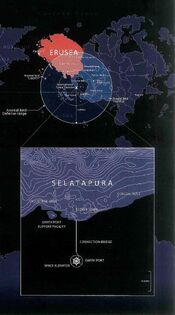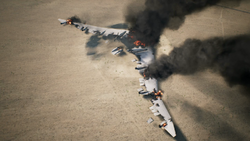- "That beast rains missiles. That's some serious shit."
- ― Clown
The Arsenal Bird,[1][2] known officially as the Aerial Arsenal Ship (AAS),[3] is a class of unmanned aerial warships that function as airborne aircraft carriers, carrying up to 80 MQ-101 UAVs at any one time. Two Arsenal Birds were developed by the Osean Federation in the 2010s to defend the International Space Elevator.[4][5]
Design
The Arsenal Birds are massive, unmanned aerial warships with wingspans of 1,100 metres (3,600 ft). They can receive commands from ground-based control centers but mostly operate autonomously using an onboard AI.[6] They can carry up to 80 MQ-101s at once. When these drones are launched, they are dropped from their holds in the aircraft's wings, flipping over and extending their wings to take flight. When exiting combat, the Arsenal Bird can recover its launched drones by docking them back into the same bays they launched from.
Arsenal Birds are also equipped with medium-range anti-air missile launchers on the dorsal wing surfaces, with the production model "Justice" having additionally been equipped with pulse laser turrets on the ventral wing surfaces and a nose mounted tactical laser beam system for attacking both surface and air targets. For long range engagements, they can launch a "Helios" missile, which uses an airburst warhead effective against aircraft.
Instead of jet engines, Arsenal Birds utilize 2 large electrically-powered contra-rotating propellers for thrust, which can provide long endurance. In addition, they have 6 smaller contra-rotating sub-propellers, which provide additional thrust to keep the carrier aloft.[6][7] The Arsenal Bird's propellers appear to have a limited self repair capacity, being shown to be able to restart destroyed engines after a short period of time.[3][8][9]

The Arsenal Birds are additionally equipped with a Microwave Powered Dome that has a large rectenna to receive microwave energy from the Lighthouse[7] via wireless transmission as their main source of electrical power. The dome also doubles as a central component of its main defensive mechanism, called the Active Protection System (APS). This defense system first projects a large halo of energy before generating a large shield of electric energy to destroy incoming projectiles and aircraft that are caught in the field.[6] It can stop attacks from all directions, even from powerful weapons like cruise missiles.[9] The APS, however has limits. It cannot stop large projectiles at an extremely high speed, such as a Mach 18 projectile from Stonehenge.[8] If the microwave transmission from the ISEV were to cease, the Arsenal Birds would stop activating APS to conserve power.[9]
Resupply and maintenance is achieved via a repurposed SSTO supply ship which attaches a reusable supply unit between the central propellers; the Arsenal Bird's internal systems become vulnerable when the resupply vessel is undocked. Using internal mechanisms, the supply unit feeds fuel to the Arsenal Bird's UAVs and provides ammunition to both the UAVs and the Arsenal Bird itself, additionally providing engine lubricant to the latter. The Arsenal Bird cannot land for repairs, and as such relies entirely on supply ship maintenance and self-repair in order to maintain constant flight.
History
The Arsenal Birds, known formally as Aerial Arsenal Ships, were developed sometime in the 2010s by a partnership between the International Space Elevator Corporation and the Osean Defense Forces to defend and support the space elevator.[3] Two units were developed; Liberty and Justice, with the former being a prototype and the latter being a production variant.[10] Liberty underwent three months of weapons and supply ship verification testing before Justice joined it in its 1200 square kilometer defense network. Both Arsenal Birds were launched from the Tyler Island Mass Driver using a combination of solid-rocket boosters and the electromagnetic catapult of the mass driver.[11] Thereafter, the mass driver was used solely to launch the supply ships that would provide ammunition, fuel, and maintenance to keep the Arsenal Birds and its UAVs in working order, rendering it a key component of the International Space Elevator's defense network.[12][13]
At the start of the Lighthouse War, Erusea swiftly captured the space elevator. The Arsenal Birds' control centers also fell under Erusean control, giving them complete control of the Arsenal Birds. This in turn gave Erusea total air superiority and hegemony over the entirety of western Usea;[8] if an attack were to occur within the Arsenal Birds' massive air defense range, Erusea could simply send one Arsenal Bird to deal with the threat, while the other would continue to defend the space elevator. This was first demonstrated on May 30, 2019, when Arsenal Bird Liberty attacked IUN forces in the Chopinburg Rainforest, forcing them to retreat after suffering heavy casualties.[3] On June 6, Liberty was deployed again against the IUN-PKF, this time at the space elevator during the IUN's failed rescue of former Osean President Vincent Harling, causing yet another retreat.[14]
On July 27, Helios projectiles were launched from at least one of the Arsenal Birds towards the Spare Squadron in the Waiapolo Mountains, but failed to destroy them.[15]

Liberty breaks apart in midair after being shot by Stonehenge
On August 19, 2019, the Osean Ground Defense Force secretly reactivated the fourth railgun of Stonehenge. Arsenal Bird Liberty was deployed to eliminate all forces in the area. With the help of the LRSSG, and despite Erusea's best efforts, Liberty received a direct hit from a Stonehenge projectile, instantly destroying its rectenna and splitting it in two amidships. Without power and falling apart, Liberty crashed in the Hatties Desert.[8] The destruction of Liberty dealt a major blow to Erusea by drastically reducing the Arsenal Birds' air defense area around the space elevator; the remaining Arsenal Bird, Justice, could not travel far from the space elevator without risking its safety. This led to Erusea losing most of its air superiority over Usea, allowing Osean forces to free over half of the Usean continent within weeks.[16]
Following the destruction of Erusea's satellite network by Osea, Justice fell into the control of the Erusean Radicals. On October 31, 2019, Justice was deployed to the space elevator in order to eliminate the Osea-Erusea coalition forces in the area. During the following engagement, Justice repeatedly activated its APS, rendering the coalition's attacks ineffective each time. After activating its APS one final time, it refused to drop it, rendering the efforts of the entire coalition pointless. However, Rosa Cossette D'Elise destroyed the location markers atop the ISEV's windbreak, leading the elevator's observation center to believe the windbreak had collapsed. This forced all microwave transmission to cease, including the Arsenal Bird's power transmission, and Justice had to drop its APS to conserve its remaining power. The coalition renewed its assault, heavily damaging Justice's propellers. Despite the damage, the Arsenal Bird remained afloat. After a suggestion from Wit, Trigger destroyed Justice's supply unit docking ports, causing the supply unit to be jettisoned from the Arsenal Bird. This left Justice's vulnerable rectenna exposed. Trigger destroyed the rectenna, triggering massive explosions and total power loss within the Arsenal Bird. With no thrust and all control lost, Justice crashed into Gunther Bay, ending the Arsenal Birds' threat for good.[9] After the conclusion of the Lighthouse War, the Arsenal Birds were deemed counterproductive to peace, and were not rebuilt. In their place, a new air defense force was formed, answering directly to the IUN but with no connection to the established IUN-PKF.[17]
Gallery
Liberty as seen from a Su-57's cockpit
An F-16C underneath Liberty
An F-22A facing Liberty in the distance
Aerial shot of Liberty over a Ulysses 1994XF04 crater
Justice and an Osean F-22A near the International Space Elevator
An F/A-18F Super Hornet with Liberty
Trivia
- The Arsenal Birds were referred to as "FAS" in 2015 promotions for Ace Combat 7.[18][5] This name may have been changed to the AAS (Aerial Arsenal Ship) designation in the final game.
- The Ace Combat 7: Skies Unknown - Strangereal Edition features a 40 cm:500g diecast model of the Arsenal Bird. Using the official 1,100-meter wingspan, this puts the diecast model at 1:2750 scale.[6]
- Knocker used the nickname "Big Baby Huey" to refer to an Arsenal Bird in Two-pronged Strategy, which is a reference to the cartoon character Baby Huey.
- The Arsenal Birds resemble aircraft such as the Northrop YB-35 and the DINFIA IA 38, notably in their flying-wing design and rear-facing propellers.
- The Arsenal Birds also resemble other fictional aircraft that were based on the YB-35's design, including the airships from Studio Ghibli's Howl's Moving Castle and the Rostock heavy bomber from The Sky Crawlers (the latter of which had a prequel game developed in part by Project Aces).
- The Arsenal Birds also resemble the Arkbird. Both incorporated similar weapons systems, were developed by Osea, and are capable of launching similar UAVs (albeit the latter was modified by the Grey Men in order to do so). They also employ identical resupply methods. The SSTO supply ships and their supply units are also of identical designs.
- In order to have unlimited station keeping time, the Arsenal Bird would require some form of self-repair. Historically all aviation endurance records have been limited by mechanical failures.
- The Arsenal Bird's propellers do not feather after being damaged, and as such would cause significant control problems during an engine shutdown.
- The new air defense force formed to replace the Arsenal Birds following the Lighthouse War is said to have "answered directly to the IUN, but had no connection to the IUN-PKF." This matches closely with the description of the UPEO from Ace Combat 3: Electrosphere, which was a peacekeeping force in Usea answering directly to the Neo United Nations (NUN).
References
- ↑ File:Ace Combat 7 Skies Unknown - New Years Showcase Trailer.
- ↑ File:Ace Combat 7 Skies Unknown - E3 2017 Trailer.
- ↑ 3.0 3.1 3.2 3.3 Mission 03: "Two-pronged Strategy", Ace Combat 7: Skies Unknown.
- ↑ File:Ace Combat 7 Skies Unknown - E3 2017 Demo Gameplay.
- ↑ 5.0 5.1 『エースコンバット7』開発陣インタビュー完全版! 「3つの軸を追求します」. Famitsu. Published December 17, 2015. Retrieved December 19, 2015.
- ↑ 6.0 6.1 6.2 6.3 Aces At War: A History 2019, page 082.
- ↑ 7.0 7.1 File:Ace Combat 7 Skies Unknown - PS4 XB1 PC - Arsenal Bird Trailer.
- ↑ 8.0 8.1 8.2 8.3 Mission 12: "Stonehenge Defensive", Ace Combat 7: Skies Unknown.
- ↑ 9.0 9.1 9.2 9.3 Mission 19: "Lighthouse", Ace Combat 7: Skies Unknown.
- ↑ https://pbs.twimg.com/media/DflfJWKU8AEjxhi.jpg
- ↑ Aces At War: A History 2019, page 086.
- ↑ Aces At War: A History 2019, page 084.
- ↑ Mission 17: "Homeward", Ace Combat 7: Skies Unknown.
- ↑ Mission 04: "Rescue", Ace Combat 7: Skies Unknown.
- ↑ Mission 09: "Faceless Soldier", Ace Combat 7: Skies Unknown.
- ↑ Mission 13: "Bunker Buster", Ace Combat 7: Skies Unknown.
- ↑ Mission 20: "Dark Blue", Ace Combat 7: Skies Unknown.
- ↑ PS4 Exclusive Ace Combat 7 Gets First Awesome 4K Screenshots and Information. DualShockers. Published December 5, 2015. Retrieved December 5, 2015. The file featuring the FAS has "FAS" in its filename. The "01" is used by other images in the same article, which means there is no secondary "-01" designation.






































